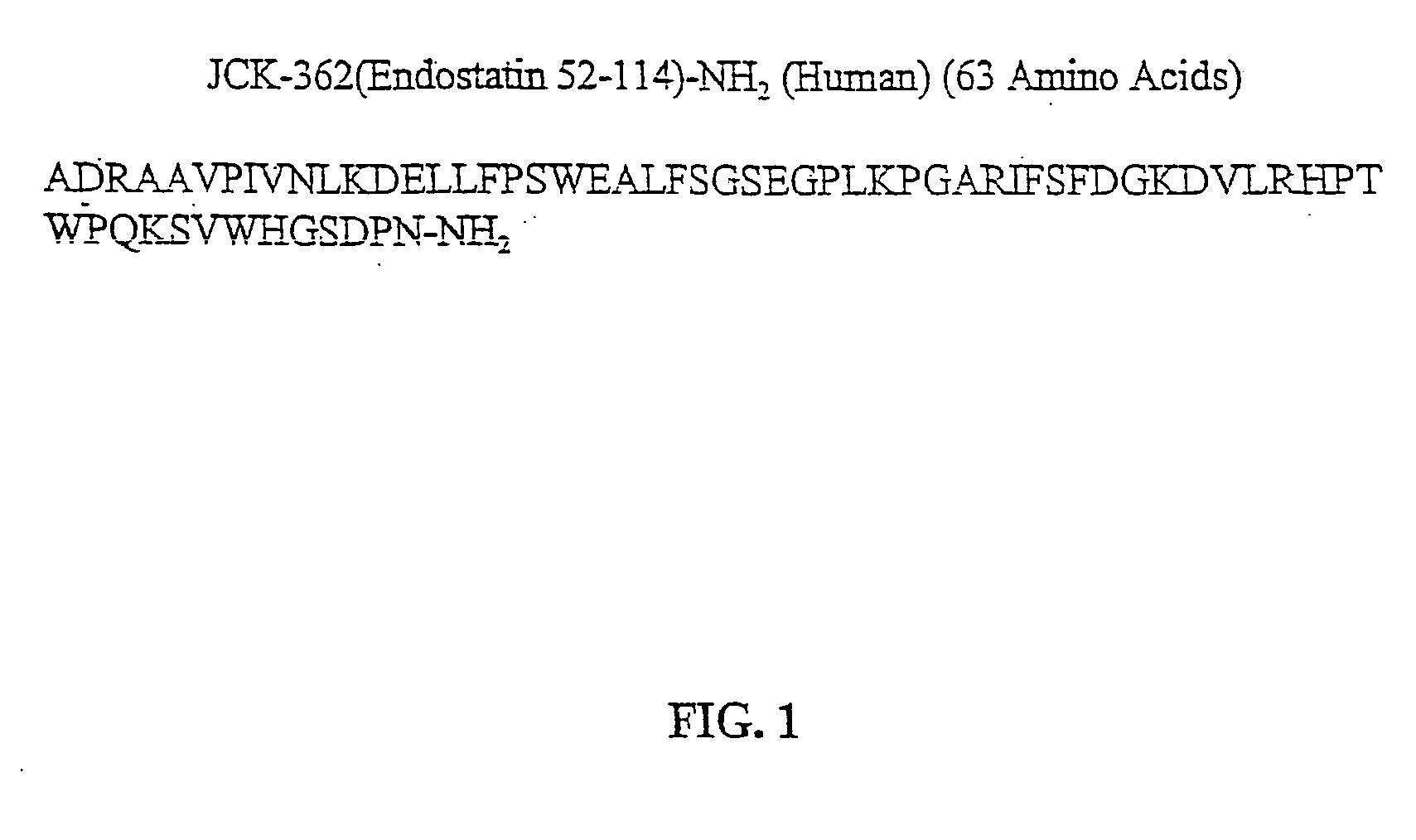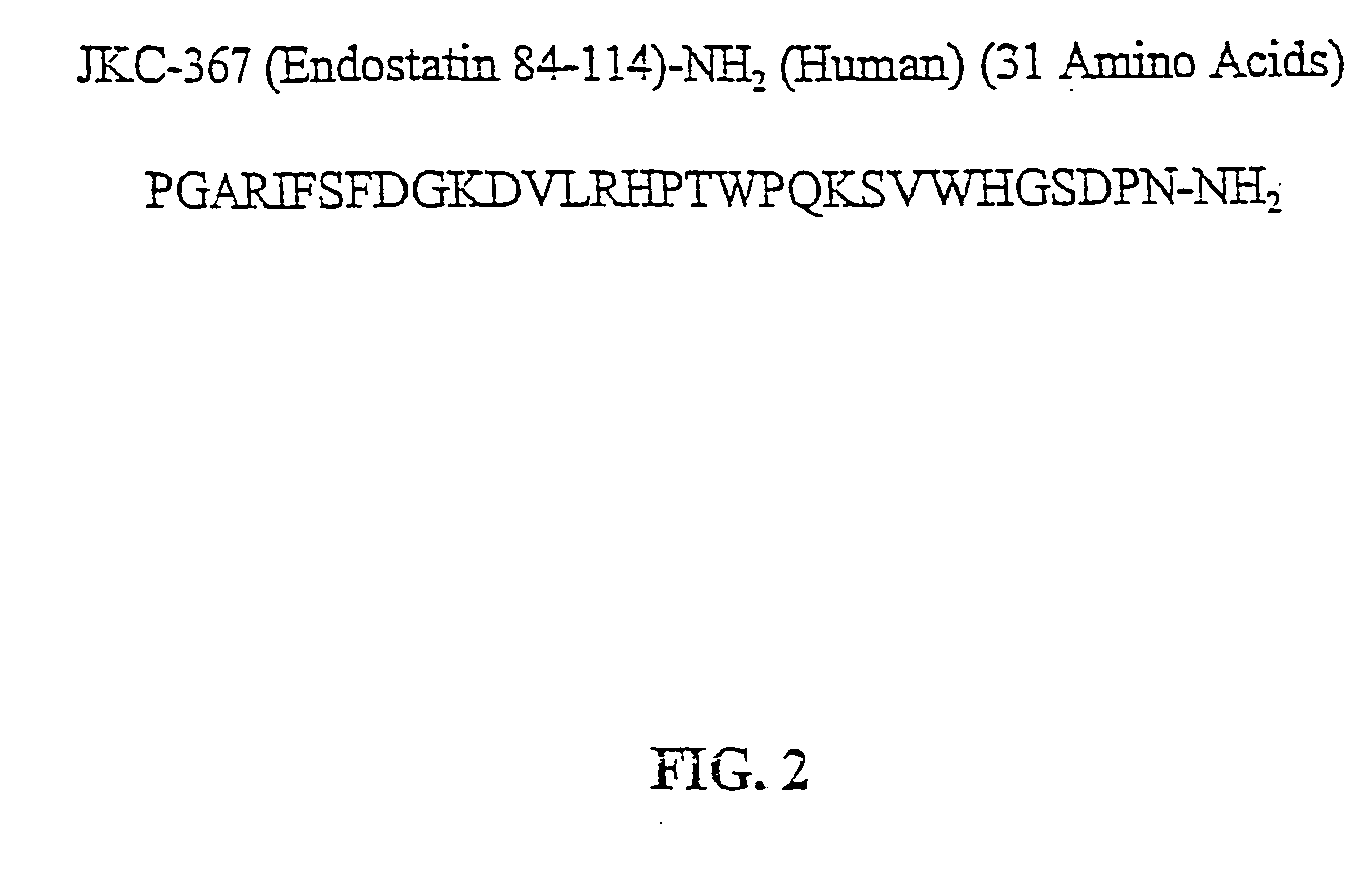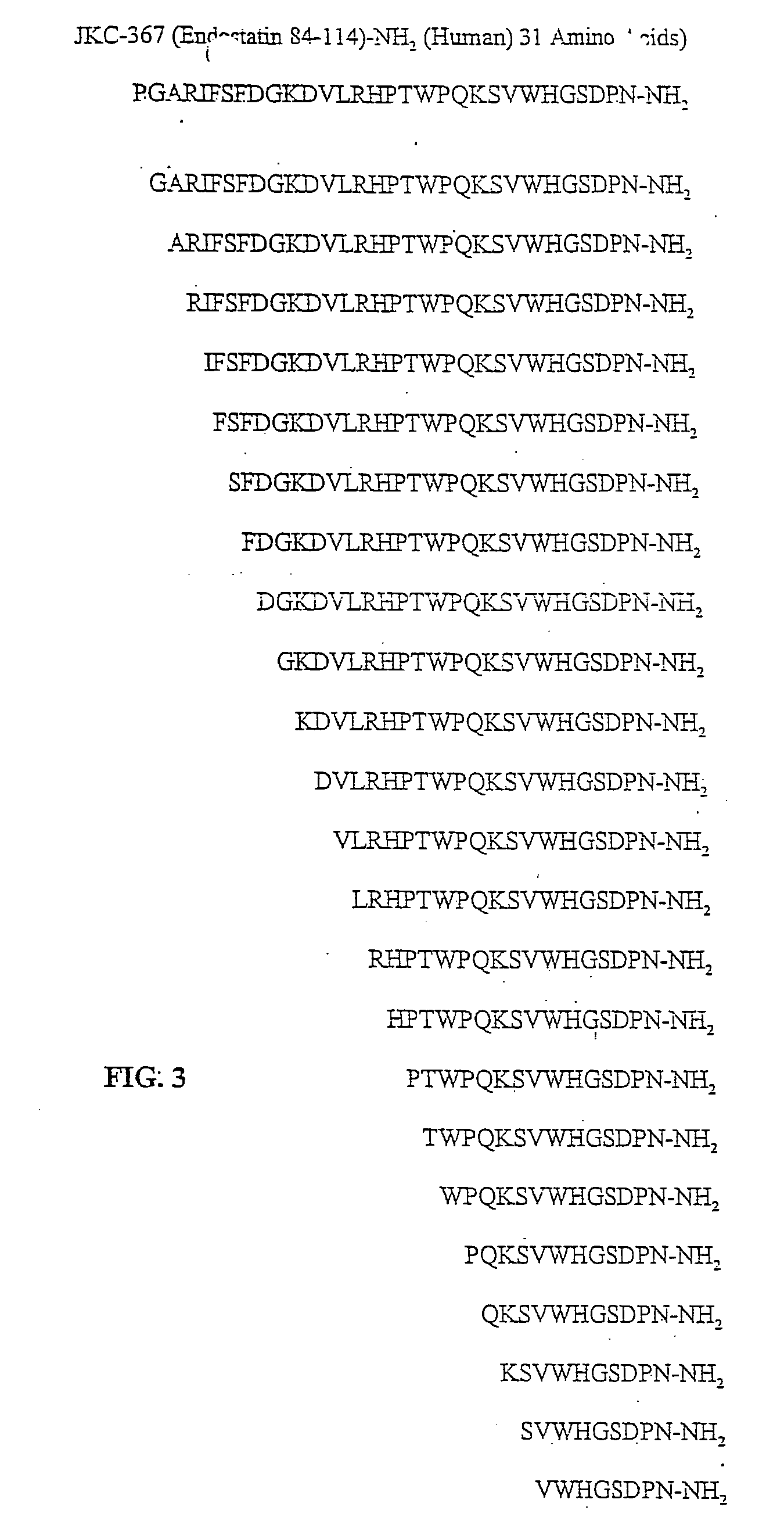In
spite of the numerous studies conducted with whole
endostatin and
angiostatin proteins, substantial problems remain unresolved with regard to providing angiogenesis inhibitors that can be commercialized, or used as
drug therapies in animals or in humans, or as angiogenic compounds in research.
A significant problem with whole
protein angiogenesis inhibitors, for example
endostatin proteins or
angiostatin proteins, can be that it may be difficult to predict what portion of the protein is biologically active.
With respect to such protein angiogenesis inhibitors, it is difficult to predict which residues encompassed by the primary structure of the protein may be responsible for the observed
angiogenesis inhibition activity.
A fourth aspect of this difficulty may be that such plurality of biologically active regions encompassed by the
primary sequence of the protein overlap one another and may not be independently excised from the
primary sequence with out disabling the other biologically active regions.
A seventh aspect of this difficulty may be that a portion of an angiogenic protein when chemically or enzymatically excised, or when identified and subsequently chemically synthesized, may not be biologically available to the target
receptor in-vitro or in-vivo.
This lack of
biological availability may be due to insolubility of the compound, a binding affinity to surrounding substrates that is greater than to the target
cell receptor,
instability of the angiogenic compound with respect to cleavage, or with respect to modification of the
peptide backbone, N-terminus, C-terminus,
side chain, or other
peptide or
chemical moiety associated with the excised or chemically synthesized portion of the protein.
Due to these, and a variety of other difficulties well known to those with skill in the art, assignment of
angiogenesis inhibition activity to any specific biochemical structure, which may be a portion of a protein, such as endostatin or
angiostatin, or any other molecule, may be unpredictable without an actual reduction to practice involving at least isolation, purification, and in-vitro and in-vivo assays to confirm
biological activity of a particular compound.
Another significant problem with the commercial development of additional novel angiogenesis inhibitors may be that small polypeptides (primary sequences comprised of 65 or fewer
amino acid residues) have not been shown to have
angiogenesis inhibition activity.
One aspect of this problem may be due to the failure to incorporate within the
primary sequence of the polypeptide the essential residues which have an affinity for the target cell
receptor.
A second aspect of this problem may be the failure to incorporate within the primary sequence of the polypeptide the essential residues which comprise the region conferring angiogenesis inhibition activity to the polypeptide.
A third aspect of this problem may be that in-vitro methods of assaying polypeptides for
biological activity may fail to properly address the
processing requirements of the polypeptide in a manner which in-vivo methods for assaying polypeptides do address.
Another significant difficulty with existing angiogenesis inhibitors may be that therapeutic results are difficult to replicate.
With respect to endostatin protein, for example, it can be difficult to reproduce results which show endostatin protein dramatically shrinks tumors.
Another significant problem with existing angiogenesis inhibitors may be stability.
Some angiogenesis inhibitors have proven to be unstable in shipment, or during subsequent routine handling, or during routine use in research studies resulting in apartial or complete loss of
biological activity.
Another significant problem with existing angiogenesis inhibitors may be that it is difficult to produce sufficient amounts for wide spread use either for research or for therapies.
The difficulty in producing large quantities of some types of angiogenesis inhibitors, including protein angiogenesis inhibitors, may present significant obstacles in developing vascularization inhibition therapy models.
Another significant problem with existing angiogenesis inhibitors may be that the effective dosages are too high.
For example, the amount of angiostatin protein used in animal studies has been criticized as being too high for clinical trials in humans.
A third aspect of high dosages with respect to conventional protein
angiogenic inhibitors may be that the protein
angiogenic inhibitors are unstable with respect to proteolytic activity, temperature, handling, or methods of in-vitro or in-vivo assays, or may have other attributes such as insolubility, a
processing requirement, or high
elimination rates in-vivo, as examples, which may render the active portions of conventional
angiogenic inhibitors biologically unavailable or at levels which are not practical for applications such as human
drug therapy.
Another significant problem with existing angiogenesis inhibitors may be that they are not suitable for use in humans.
One aspect of this problem can be that such angiogenesis inhibitors comprise proteins derived from species other than human.
Another significant problem with existing angiogenesis inhibitors may be
solubility.
One aspect of this problem may be that angiogenic inhibitor proteins become denatured during isolation or purification and may subsequently become insoluble as such proteins unfold presenting additional hydrophobic core residues.
A second aspect of this problem may be that only a small percentage of the unfolded protein may spontaneously refold, and an even smaller percentage of the
protein molecules may refold properly.
A third aspect of this problem may be that unfolded insoluble angiogenic proteins may have to be injected as a suspension of particulate.
This may make the preparation of the appropriate dosage more difficult or more
time consuming.
It is well known to those with skill in the art that injecting insoluble suspensions of proteins, peptides, or protein-
peptide conjugates into animals often stimulates the production of antibodies to such insoluble particulate, however, the results of immunization of animals with such insoluble particulate may not be predictable even when using what appears to be the same amount of suspended particulate.
Another problem with generating additional novel angiogenesis inhibitors may be that compounds which may fail to show inhibition of angiogenic activity in-vitro may show unexpectedly high levels of angiogenic inhibition activity in-vivo.
However, it is now understood that stable water soluble polypeptides may show no effect in-vitro but still retain the ability to reduce the volume of established xenographs in-vivo.
As generally mentioned above, and specifically with respect to endostatin protein, it is unpredictable and difficult to assess which portions of a protein may encompass observed biologically active.
Another problem with generating additional novel angiogenesis inhibitors may be that the molecular structure may not be chemically synthesized in substantial quantity.
Angiogenesis inhibiting proteins such as endostatin (184 residues) and angiostatin (200) may not be able to be chemically synthesized with any substantial success.
Conventional methods of
chemical synthesis resulting in substantial quantities of purified peptide (over 10 milligrams) are typically limited to peptide sequences having fewer than 70 residues.
Another problem with generating additional novel angiogenesis inhibitors may be that both the human and mouse counterparts of the same angiogenic inhibitor may not be available.
 Login to View More
Login to View More 


